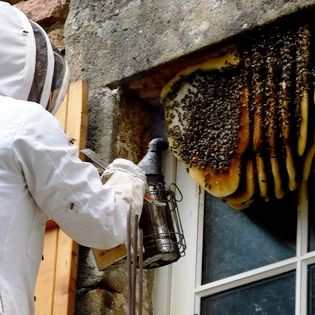Bee activity around homes is nothing new, but when an unexpected infestation arises, it can be both alarming and inconvenient. Bees inspection in Melbourne becomes crucial when signs of nesting, buzzing, or structural damage appear suddenly; especially from less aggressive species like Leafcutter bees. While these bees aren’t typically dangerous, they can still affect your property, garden, or peace of mind if left unmanaged.
This blog offers practical guidance on identifying and managing bee infestations in Melbourne homes, focusing on responsible action, safety, and understanding the types of bees you’re dealing with.
Understanding the Bee Species in Melbourne Homes
Melbourne is home to a wide variety of native and introduced bee species. Not every bee behaves the same, which is why it’s important to know what kind of bee you’re dealing with.
Some bees, like Leafcutter bees, are solitary and non-aggressive. These bees are most active in spring and summer and often nest in soft wood or gaps between bricks. Their presence is typically marked by neat, circular cuts in plant leaves; used to line their nests.
Other bee species that may appear in or around Melbourne homes include:
- Honey bees – social bees that live in large hives, often in wall cavities or roof spaces.
- Carpenter bees – solitary bees that drill into untreated wood to lay eggs.
- Blue-banded bees – known for their vibrant colouring and fast flight, often nest in soft mortar or clay soil.
Different species require different removal approaches, which makes accurate identification a key step before taking action.
Signs of a Bee Infestation You Shouldn’t Ignore
Bee infestations don’t always announce themselves with aggressive swarms. Some of the most common signs you might notice around your property include:
- Constant buzzing near a wall, ceiling, or tree trunk.
- Visible bee entry points, such as small holes in timber, soil, or cracks in walls.
- Soft, papery buzzing sounds inside walls or roofs.
- Clusters of bees around specific outdoor areas like decks, sheds, or brickwork.
- Circular cuts in leaves, especially from Leafcutter bees.
In the case of solitary species like Leafcutter bees, you may not see a swarm but could still have several nests across your garden or external walls.
Being aware of these signs can help homeowners act early; before the infestation becomes a safety concern or causes property damage.
Why Leafcutter Bees Are Unique and Still a Concern
Leafcutter bees are often overlooked because they don’t sting unless provoked and aren’t aggressive by nature. However, their nesting habits can lead to unexpected property concerns.
These bees nest in soft wood, garden reeds, small holes, or even in insulation and air vents. Though not destructive like termites, their constant nesting can weaken structures or interfere with man-made installations like irrigation systems or outdoor furniture.
They also tend to return to the same nesting sites each season, which can create a growing issue if left unmanaged. While beneficial as pollinators, uncontrolled Leafcutter activity might result in unsightly damage to your garden and minor structural wear over time.
DIY Bee Removal: Risks and Considerations
Some homeowners may attempt to manage bee infestations on their own, especially if the species appears harmless. However, this approach often carries hidden risks:
- Incorrect species identification may result in harm to beneficial or protected bees.
- Inadequate removal can leave parts of the nest behind, inviting re-infestation.
- Use of chemicals or sprays may impact children, pets, or native wildlife.
- Unintended harm to pollinators disrupts local biodiversity.
For example, spraying or blocking Leafcutter bee nests without understanding their behaviour can force them into new, more intrusive areas; like wall cavities or roof beams.
Instead of DIY measures, a trained professional can identify the species and offer a safe removal plan that protects your home and the bees whenever possible.
When to Call for a Professional Bee Inspection
Professional help is recommended when:
- Bees are nesting within the structure of your home (walls, roofs, vents).
- You’re unable to identify the bee species confidently.
- There’s visible damage or a strong, persistent bee presence.
- You’ve had repeated infestations in the same area.
A licensed pest control technician can conduct a thorough inspection, determine the species, and plan a removal strategy that avoids harm to the bees or your property.
In fact, many providers now offer eco-conscious removal methods that include relocation rather than extermination, especially for solitary native bees.
Post-Removal Care and Long-Term Prevention
Once bees are removed, the job isn’t over. Proper post-removal care ensures that the infestation doesn’t return. Here’s what you should do:
- Seal entry points like cracks, gaps, or holes in walls and timber.
- Replace damaged wood or insulation where nesting occurred.
- Use bee deterrents like mesh over vents or natural plant oils in entry zones.
- Monitor leaf activity in gardens, particularly from spring to late summer.
Homeowners who’ve dealt with Leafcutter bees should also monitor plant life for continued leaf damage, a sign that bees may be returning to the area.
Taking proactive steps not only keeps bees from coming back but also maintains a healthy balance between nature and your living space.
Make Your Next Move with Confidence
Unexpected bee infestations don’t need to cause panic. Whether you’re noticing small holes in timber, leaf damage in your garden, or gentle buzzing in your walls, early action makes all the difference.
Professional assessment and removal ensure the bees are relocated safely, your home remains secure, and your family stays protected. In some cases, quick action can also reduce the overall bee removal cost in Melbourne, particularly if the problem is caught before major property damage occurs.
For a clear, safe, and effective plan, contact Bees Removal Melbourne today. Call 03 9021 3762 to arrange a property inspection and enjoy expert help tailored to your home and the bees involved.




